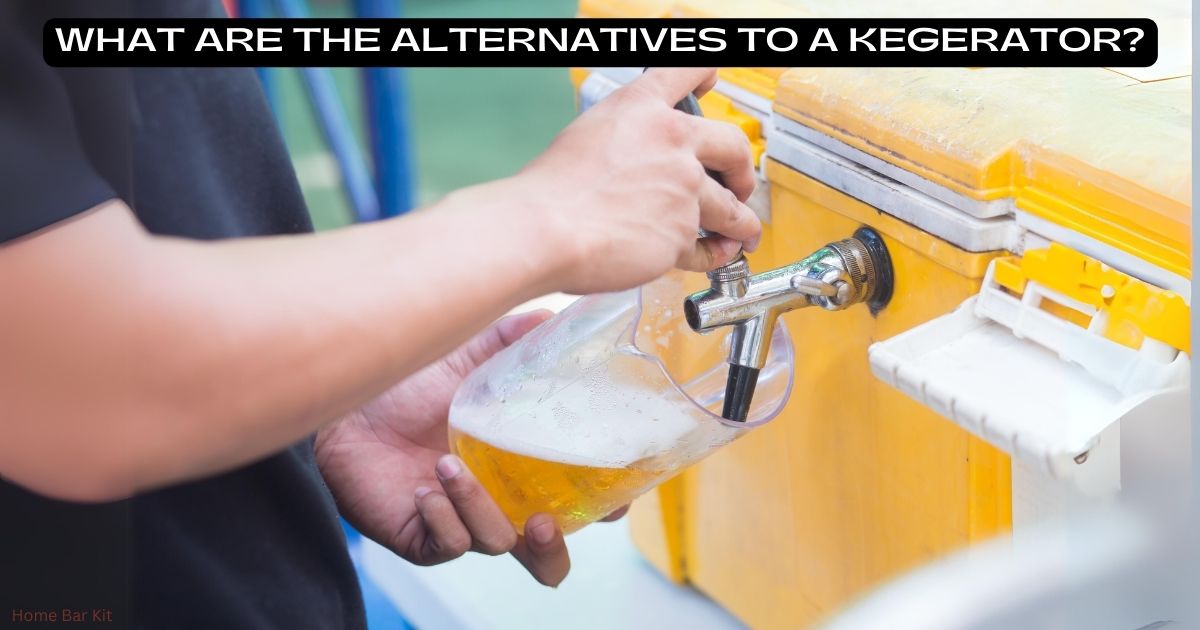A kegerator is essentially a refrigerator specially designed to store and dispense kegs of beer. Which makes it a great addition to a home bar or pub shed. However they are pretty expensive, so is there an alternative to a kegerator?
There are a few alternatives to a kegerator all different in their own way, but essentially performing the same beer tap experience. The first is a simple, a compact beer dispenser. Second, there is a DIY version which involves converting a regular fridge into a kegerator. And third, the jockey box which is a portable version of a kegerator.
All three kegerator alternatives have their advantages and disadvantages, so it really comes down to personal preference as well as budget.
- What Is A Kegerator?
- Kegerator Alternatives
- Pros and Cons: Kegerator vs. Its Alternatives
- Final Thoughts
What Is A Kegerator?
A kegerator is an appliance used for beer storage and dispensing, as well as home brewing too. It is like a mini pub set up without the need for a large system involving cooling units, pipe runs and large gas tanks.
A kegerator is like a mini pub set up in a neat fridge like unit that will keep beer fresh, bubbly, and cold. It combines the functionality of a refrigerator with beer-dispensing equipment, typically including a small CO2 tank, a regulator, and a beer tap.
These are the components that make up a kegerator: the keg holds the beer, the CO2 tank and regulator carbonize and feed the beer to the tap handle which in turn fills your beer glass.
A real pub experience in your own home bar.
One of the top benefits of using a kegerator is certainly the quality and longevity of the beer. It cuts out the hassle of stocking up cans and bottles. Plus the kegs reduce the waste from cans, bottles and packaging.
Kegerator Alternatives
If you want beer on tap in your home bar or pub shed, then why wouldn’t you just get a kegerator. Why look for alternatives?
Mainly because they are pretty expensive, and if you are tight on space then you could say they are bulky too.
Which is why there are some alternatives for enjoying a cold beer on tap at home. From the compact beer dispenser, a DIY conversion to the portable jockey box.
Beer Dispenser
First on the list is the draught beer dispenser. It’s like a kegerator in that you have beer on tap, but comes as a smaller, more portable unit. These dispensers often use mini kegs and are easy to set up – you just plug them in, let them chill, and you’re ready to pour a fresh pint.
What’s great about draught beer dispensers is their user-friendliness and the fact that they don’t take up much space. Whether you’re just enjoying a pint in your home bar or a small party, these can be a great choice.
Because of their simplicity, there’s minimal maintenance to worry about. Plus, they are a fraction of the cost of the kegerator
Fridge Conversion
The next alternative is the DIY route – converting a fridge into a kegerator. It might sound a little daunting; but with some basic tools and a conversion kit, you can transform an old fridge into a home made kegerator.
The process involves installing a beer tap on the door, adding a CO2 tank and a keg inside, and connecting everything with lines.
The alternative to a tap on the door is to run a beer line from the fridge to a beer tap on your bar top.
It’s a fairly easy project to turn a fridge into a kegerator. A conversion kit can cost a few hundred smackers, but if you buy all the parts separately, then this can save money, making it a cheap alternative.
Baically you can go as simple or as fancy as you want with the hardware.
Jockey Box
Finally, we have the jockey box, which looks like a large cool box with beer taps attached to it. This option is quite different from the others as it’s specifically designed for temporary use, like outdoor events or picnics.
A jockey box uses coils submerged in ice water to chill your beer as it’s poured, which means you don’t need electricity.
Jockey boxes are compact and incredibly portable, but keep in mind that they are for use during events rather than continuous daily pouring.
Also the kegs and gas are set up externally, just like a pub set up. So the jockey box itself maybe quite compact, but the rest of the kit can take a fair bit of space.
Pros and Cons: Kegerator vs. Its Alternatives
While each beer tap system does pretty much the same thing. The kegerator as well as its alternatives all have there own set of advantages and disadvantages.
They are important to consider before you make your choice. Here are each ones pros and cons, in my opinion.
“As an Amazon Associate I earn from qualifying purchases.”
Kegerator
With a kegerator, your beer stays fresh and perfectly chilled for a good period of time. They are very well designed and easy to set up and use, making them a good option and alternative to a complete pub set up.
There is also the option of a single tap kegerator, as well as a two or even three tap version. Although the more taps will increase the size of the unit.
The downside is that kegerators can be a bit of an investment, they are not a cheap bit of kit. Also if room is tight they take up more space than other options.
Beer Dispensers
Moving on to draught beer dispensers, these are a counter top alternative to the kegerator.
These are way more compact which is great for small spaces. Because they are so compact, they are easy to move around, so can be used for events too, as long as there is an electrical point.
However, their smaller size can also means a limited selection of beers and frequent refilling. Having said that, there are more and more beer options available as time goes on.
The kegs for these small units are normally 5 to 6L (approx 9 to 10 pints) which is fine for personal use, but have a few friends round to your home bar and they won’t last long.
Cost wise they are not too bad, just a few hundred quid for the beer dispensing unit, but in my opinion the kegs are quite expensive and the price per pint is not far off what you might pay in a pub.
Fridge Conversion
Converting a fridge is a good DIY project and can be cost-effective if you’ve got an old fridge lying around.
Customisation is a big plus, letting you design the setup to your own needs. You can use small to medium kegs, as well as beer in a bag or your own home brew.
Talking of home brew, with the addition of a small tube heater and a temperature control thermostat you can also use your converted kegerator as a fermentation unit. This keeps your fermenting beer at the right temperature.
A downside is that a conversion kit can be expensive, which makes it less cost effective. However if you put in a little time and effort you can slash the cost of a conversion kit by buying everything separately.
As a fridge is a similar size to a one tap kegerator, if space is tight then a fridge conversion may not be ideal.
Jockey Box
Jockey boxes are fantastic for outdoor events like tailgates or beach parties. A big plus is that they’re portable and don’t require electricity.
Although the units themselves are quite neat and compact, they do require kegs, beer lines, gas and regulators. All of which are set up externally to the unit itself, which is fine for an event, but not as suitable for a home bar or pub shed.
They also require ice and more setup time, and they aren’t ideal for long-term storage – you’ll need another solution when the party’s over.
Final Thoughts
The kegerator itself and the alternatives all have their own pros and cons, so it really comes down to personal choice, circumstances and budget.
Kegerators stand out for their professional quality and built-in features, while draught beer dispensers offer compact and sometimes portable convenience. Fridge conversions are a great DIY alternative, giving custom options with cost-effectiveness. Jockey boxes are the best for event and those looking for a mobile solution.
Your choice should reflect your personal circumstances and preferences. Think about how much space you have, your budget, and how often you entertain or move your beer-serving setup.
For me I wanted something that would accommodate home brew for both fermentation and serving afterwards.
I am in the process of converting a fridge into a kegerator as well as a fermentation unit. So far I have the fridge which is a secondhand one that cost peanuts. I have an Inkbird Temperature Control Thermostat and a Tube Heater. As well as a beer engine for drawing the beer from the DIY kegerator.
I still need to get some beer line, keg and accessories, I am researching my best options on these at the moment.
So for my circumstances I am opting for the fridge conversion, which best suits my needs.
What about you, share your thoughts below on what option suits you, whether you are looking to set up a beer tap system at home, or already have one.
Once my set up is complete I will update here and let you know how its going.
Rob is a passionate home bar and pub shed enthusiast with a passion for craft beer. With hands-on experience in designing and building his own home bar, Rob shares his knowledge, tips, and inspiration to help fellow enthusiasts create their own perfect space. Alongside the world of home bars and pub sheds, Rob also explores the diverse and exciting realm of craft beer, providing honest reviews to help you discover your next favorite brew. Join Rob on a journey of flavor, design, and craftsmanship right here on Home Bar Kit.

